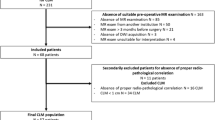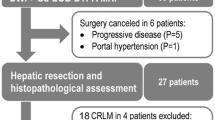Abstract
Purpose
This study assessed the capability of magnetic resonance (MR) diffusion-weighted imaging (DwI) with measurement of apparent diffusion coefficient (ADC) in both predicting and evaluating the response to chemotherapy (CHT) of liver metastases by itself and along with preliminary dimensional assessment.
Methods and materials
Patients affected by liver metastases from cancers of the digestive tract and breast were prospectively enrolled and underwent computed tomography and MR-DwI before CHT (time 0) and 20–25 days after the beginning of the second cycle (time 3). Moreover, MR-DwI was performed 10–15 (time 1) and 20–25 days (time 2) after the beginning of the first cycle. Maximum diameter and mean ADC value (×10−3 mm2/s) of metastases were evaluated. Lesions were classified as progressive disease (PD), stable disease (SD) or partial response (PR) according to dimensional changes between time 0 and time 3, following RECIST 1.1 indications. Clinically, PD lesions were defined as nonresponding (NR), and SD and PR lesions as responding (R). Analysis of variance and ROC analyses were performed (significance at p < 0.05).
Results
Eighty-six metastases (33 patients) were classified as follows: 15 PD, 39 SD and 32 PR without significant differences in mean ADC values among the groups before CHT and at all corresponding times. The mean ADC values of SD and PR groups at times 1 (respectively 1.66 ± 0.36 and 1.59 ± 0.23), 2 (1.72 ± 0.42 and 1.68 ± 0.37) and 3 (1.86 ± 0.44 and 1.73 ± 0.39) were significantly higher than the corresponding values at time 0 (1.50 ± 0.30 and 1.39 ± 0.33). An accurate cutoff value of ADC increase or diameter decrease for the early identification of R or NR lesions was not found.
Conclusion
The pretreatment ADC value of a liver metastasis does not seem useful in predicting the CHT outcome. A trend towards early ADC increase, alone or occurring with dimensional decrease, may be a good indicator of a responding lesion.





Similar content being viewed by others
References
Provenzale JM, Mukundan S, Barboriak DP (2006) Diffusion-weighted and perfusion MR imaging for brain tumor characterization and assessment of treatment response. Radiology 239:632–649
Heijmen L, Voert EEGW, Nagtegaal ID, Span P et al (2012) Diffusion-weighted MR imaging in liver metastases of colorectal cancer: reproducibility and biological validation. Eur Radiol 23:748–756
Koh DM, Collins DJ (2007) Diffusion-weighted MRI in the body: applications and challenges in oncology. AJR Am J Roentgenol 188:1622–1635
Chung W-S, Kim M-J, Chung YE et al (2011) Comparison of gadoxetic acid-enhanced dynamic imaging and diffusion-weighted imaging for the preoperative evaluation of colorectal liver metastases. J Magn Reson Imaging 34:345–353
Cui Y, Zhang XP, Sun YS et al (2008) Apparent diffusion coefficient: potential imaging biomarker for prediction and early detection of response to chemotherapy in hepatic metastases. Radiology 248:894–900
Colagrande S, Pasquinelli F, Mazzoni LN (2010) MR-diffusion weighted imaging of healthy liver parenchyma: repeatability and reproducibility of apparent diffusion coefficient measurement. J Magn Reson Imaging 31:912–920
Eisenhauer EA, Therasse P, Bogaerts J et al (2009) New response evaluation criteria in solid tumours: revised RECIST guideline (version 1.1). Eur J Cancer 45:228–247
Rockwell S, Dobrucki IT, Kim EY et al (2009) Hypoxia and radiation therapy: past history, ongoing research, and future promise. Curr Mol Med 9:442–458
Vaupel P, Mayer A (2007) Hypoxia in cancer: significance and impact on clinical outcome. Cancer Metast Rev 26:225–239
Kim SH, Lee JM, Hong SH et al (2009) Locally advanced rectal cancer: added value of diffusion-weighted MR imaging in the evaluation of tumor response to neoadjuvant chemo- and radiation therapy. Radiology 253:116–125
DeVries AF, Kremser C, Hein PA et al (2003) Tumor microcirculation and diffusion predict therapy outcome for primary rectal carcinoma. Int J Radiat Oncol Biol Phys 56:958–965
Harry VN, Semple SI, Gilbert FJ, Parkin DE (2008) Diffusion-weighted magnetic resonance imaging in the early detection of response to chemoradiation in cervical cancer. Gynecol Oncol 111:213–220
Nilsen L, Fangberget A, Geier O et al (2010) Diffusion-weighted magnetic resonance imaging for pretreatment prediction and monitoring of treatment response of patients with locally advanced breast cancer undergoing neoadjuvant chemotherapy. Acta Oncol 49:354–360
Koh DM, Scurr E, Collins D et al (2007) Predicting response of colorectal hepatic metastasis: value of pretreatment apparent diffusion coefficients. AJR Am J Roentgenol 188:1001–1008
Mardor Y, Roth Y, Ochershvilli A et al (2004) Pretreatment prediction of brain tumors’ response to radiation therapy using high b-value diffusion-weighted MRI. Neoplasia 6:136–142
Theilmann RJ, Borders R, Trouard TP et al (2004) Changes in water mobility measured by diffusion MRI predict response of metastatic breast cancer to chemotherapy. Neoplasia 6:831–837
Song I, Kim CK, Park BK, Park W (2010) Assessment of response to radiotherapy for prostate cancer: value of diffusion-weighted MRI at 3 T. AJR Am J Roentgenol 194:477–482
Hayashida Y, Yakushiji T, Awai K et al (2006) Monitoring therapeutic responses of primary bone tumors by diffusion-weighted image: initial results. Eur Radiol 16:2637–2643
Pickles MD, Gibbs P, Lowry M, Turnbull LW (2006) Diffusion changes precede size reduction in neoadjuvant treatment of breast cancer. Magn Reson Imaging 24:843–847
Marugami N, Tanaka T, Kitano S et al (2009) Early detection of therapeutic response to hepatic arterial infusion chemotherapy of liver metastases from colorectal cancer using diffusion-weighted MR imaging. Cardiovasc Interv Radiol 32:638–646
Heijmen L, Verstappen MCHM, Voert Ter EEGW et al (2012) Tumour response prediction by diffusion-weighted MR imaging: ready for clinical use? Crit Rev Oncol Hematol 83:194-207
Löwenthal D, Zeile M, Lim WY et al (2011) Detection and characterisation of focal liver lesions in colorectal carcinoma patients: comparison of diffusion-weighted and Gd-EOB-DTPA enhanced MR imaging. Eur Radiol 21:832–840
Acknowledgments
This work was funded by SIRM (Società Italiana Radiologia Medica).
Conflict of interest
Francesco Mungai, Filippo Pasquinelli, Lorenzo Nicola Mazzoni, Gianni Virgili, Alfonso Ragozzino, Emilio Quaia, Giovanni Morana, Andrea Giovagnoni, Luigi Grazioli and Stefano Colagrande declare no conflict of interest.
Author information
Authors and Affiliations
Corresponding author
Rights and permissions
About this article
Cite this article
Mungai, F., Pasquinelli, F., Mazzoni, L.N. et al. Diffusion-weighted magnetic resonance imaging in the prediction and assessment of chemotherapy outcome in liver metastases. Radiol med 119, 625–633 (2014). https://doi.org/10.1007/s11547-013-0379-3
Received:
Accepted:
Published:
Issue Date:
DOI: https://doi.org/10.1007/s11547-013-0379-3




